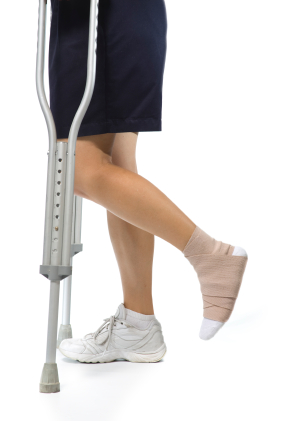Ankle sprains are the most common injury in high school sports. (1) Most athletes will land on the outside of the foot and roll, often experiencing a "pop," followed by pain and swelling.
A majority of athletes will recover over the course of a few days or weeks, strap on an off-the-shelf brace, and return to sports. After getting out of the brace, an athlete will regain normal motion,
strength, and gait over the course of the next several weeks. Those who suffer a broken leg or ankle, however, will end up wearing a boot for 6 weeks.  In both cases, some treatment or rehabilitative exercises are necessary to regain full strength and athletic ability.
In both cases, some treatment or rehabilitative exercises are necessary to regain full strength and athletic ability.
A very common, but often overlooked problem with lower leg injuries is that a secondary injury can occur, such as posterior tibialis tendonitis, a painful inflammation and injury along the lower inside part of the leg, ankle, and arch of the foot. Such an injury may follow a lower leg injury and, if not treated immediately, may keep an athlete out of sports for several more weeks of inactivity and require additional therapy. As a result, it is important for athletes, parents, and coaches to recognize the warning signs and to respond appropriately.
Signs of posterior tibialis tendonitis
Posterior tibialis tendonitis is a condition often characterized by:
- Pain to touch along the lower inside part of the leg/shin that courses around the inside ankle
- Pain with full weight bearing through the foot into the lower leg
- Tightness or irritation when stretching the foot into dorsiflexion and eversion (ankle moving up and away from middle)
- Inability to land from jumping or running which progesses into difficulty walking, climbing stairs, or standing
- Tenderness along the arch of the foot
The posterior tibialis plays a critical role in weight bearing through the foot. As an athlete steps, the muscle pulls upward to support the arch of the foot. If the muscle isn't working properly, the inside arch will flatten, resulting in injury to the bones and soft tissue.
A different type of injury
The three common causes for this secondary injury are:
- Changes in running/walking/jumping pattern due to pain along outside of ankle;
- Swelling throughout the joint decreasing overall strength and mobility; and
- Weakness resulting from the athlete having his foot in a boot or being on crutches for several weeks.
Unlike an ankle sprain, this condition cannot be braced. Ankle support products control the motion at the ankle, preventing the joint from rolling to the inside and outside. But this particular muscle controls impact through the foot, meaning arch supports will only help a little. When the muscle is sufficiently irritated, simply walking becomes too painful.
Recognition and prevention
This injury, unlike ACL or rotator cuff tears, is not well known and
often overlooked. Many athletes will assume the inner ankle pain is normal when returning
to full activity. So, the best way to prevent posterior tibialis tendonitis secondary to a previous lower leg injury is awareness.
If an athlete returning to sports is complaining of pain on the outside of the ankle, which is the site of the previous injury, this sensation is usually normal and the pain will eventually go away. But if the originally injury was a broken foot, ankle stress fracture, or lateral ankle sprain and your athlete complains of pain on the inside of the foot and ankle, it's time to call the doctor. Early intervention, education, and proper treatment are critical. This type of injury, if addressed immediately, can go away just as fast as it shows up. But if the tendonitis is left untreated and allowed to worsen for weeks or months, it will often take the same length of time to completely heal.
Keith Cronin is a physical therapist in the St. Louis area and a MomsTeam expert.
1. Swenson D, Collins C, Fields S, Comstock R. Epidemiology of US High School Sports-Related Ligamentous Ankle Injuries, 2005/06-2010-11. Clin J Sport Med 2013;23(3):190-196.
Posted March 9, 2011, updated May 21, 2013








